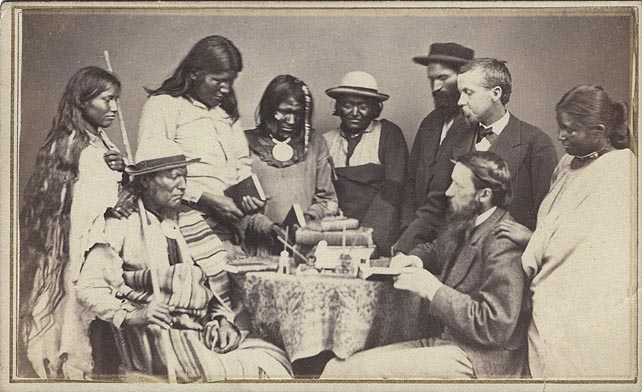mesc2.html


Mescalero Apaches with A. J. Curtis
N. Brown & Son, Photographers
Inscribed on verso: “Compliments of A. J. Curtis, U.S. Agent for Mescalero Apaches/Fort Stanton N. M.”
In 1862, there were fewer than a thousand Mescaleros living in scattered bands between the Rio Grande and the Pecos, when Federal troops known as the California Column marched into New Mexico under the command of General James Carleton. With no Confederates around to fight (they had fled into Texas), Carleton turned his attention to the Indians–and to the mineral wealth he suspected was waiting to be discovered beneath their lands. Before taking on the more-numerous Navahos, Carleton planned to kill or capture all of the Mescaleros, and send the survivors to a worthless reservation along the Pecos. An order he issued in September of 1862 instructed his troops: “There is to be no council held with the Indians, nor any talks. The men are to be slain whenever and wherever they can be found. The women and children may be taken as prisoners, but, of course, they are not to be killed.”
Thanks to the intervention of Kit Carson, lines of communication were opened and five Mescalero chiefs agreed to negotiate with General Carleton at Santa Fe. On their way, two of the chiefs and their escorts were ambushed and slaughtered by Captain James (Paddy) Graydon, who feigned friendship for them with gifts of provisions. When the other three chiefs arrived in Santa Fe, they asked to be left in peace in their mountains. But Carleton gave them no choice: they would have to go to the Bosque Redondo, the reservation he had chosen for them.
Once the Mescaleros arrived at the reservation, Kit Carson reluctantly rounded up the Navahos under orders from General Carleton. It took years of warfare; the Navahos who surrendered were marched in groups from the Four Corners region–the punishing “Long Walk.” At the Bosque Redondo, the Mescaleros and the Navahos endured extreme hardships–poor soil, brackish water, shortages of food, clothing and medicine— and they fought one another. Finally, the Mescaleros simply disappeared in the darkness of a single night. They were never recaptured. During the 1870s, they received reservation lands in their traditional strongholds around Sierra Bianco. The Navahos were not released until General Carleton left New Mexico and Gen. William T. Sherman signed a new treaty with them in 1868.
The carte de visite of A. J. Curtis (seated at right) with the Mescaleros may have been taken before their forced relocation. Curtis appears to be distributing books to the Indians, but the significance of that is not presently known.
Sources: Bury My Heart at Wounded Knee, An Indian History of the American West by Dee Brown
Pam Ostreicher, Ph.D. of American Social History and Social Movements, Pittsburgh
< P R E V I O U S I M A G E N E X T I M A G E >
SMALL WORLDS: The Art of the Carte de Visite
Copyright © 1998 The American Museum of Photography
